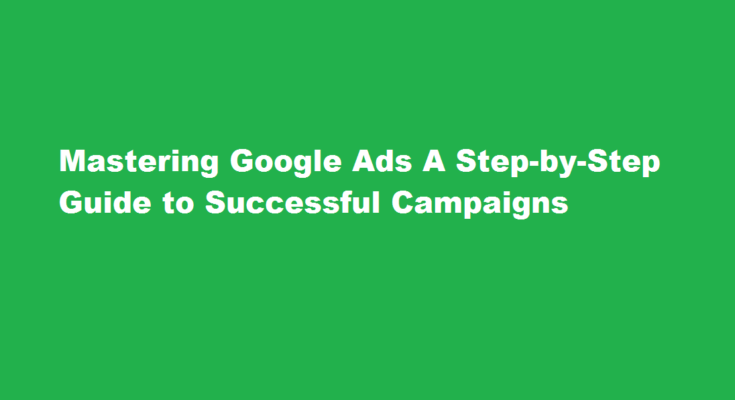Introduction
Google Ads has become a powerful tool for businesses to reach their target audience and drive conversions. However, running effective Google Ads campaigns requires careful planning and execution. In this article, we will explore a step-by-step guide on how to run Google Ads successfully, ensuring maximum return on investment (ROI) and achieving your marketing goals.
Define Your Objectives and Target Audience
Before diving into Google Ads, it’s essential to define your campaign objectives. Whether it’s increasing brand awareness, driving website traffic, or generating leads, clarity on your goals is crucial. Additionally, understanding your target audience’s demographics, interests, and online behaviors will help tailor your campaigns effectively.
Conduct Keyword Research
Keyword research is the backbone of any successful Google Ads campaign. Identify relevant keywords related to your products, services, or industry using tools like Google Keyword Planner or SEMrush. Focus on keywords with high search volumes, low competition, and strong relevance to your business. Incorporate these keywords strategically into your ad copy and landing pages to enhance your campaign’s visibility and quality score.
Structure Your Campaigns
Organize your Google Ads account into well-structured campaigns and ad groups. Create separate campaigns based on different products, services, or geographic locations. Within each campaign, group related keywords into ad groups. This allows you to create highly targeted ads and landing pages that align with the user’s search intent, improving your ad relevance and quality score.
Craft Compelling Ad Copy
Crafting persuasive ad copy is essential for capturing your audience’s attention. Highlight unique selling points, benefits, or promotions to entice users to click on your ads. Use strong calls-to-action (CTAs) to encourage desired actions. Experiment with different ad formats, such as text ads, responsive search ads, or display ads, to find what works best for your audience. Regularly test and refine your ad copy to optimize performance and maximize click-through rates (CTRs).
Design Optimized Landing Pages
Sending users to a well-designed and relevant landing page is critical for converting clicks into actions. Ensure that your landing pages align with your ad copy, provide valuable information, and have clear CTAs. Optimize landing page load times, make them mobile-friendly, and use persuasive elements like testimonials, reviews, or product images to build trust and drive conversions. Regularly monitor and optimize your landing pages to improve user experience and maximize conversion rates.
Set Up Conversion Tracking and Analytics
Implement conversion tracking to measure the effectiveness of your Google Ads campaigns accurately. Set up conversion goals, such as form submissions, purchases, or newsletter sign-ups, and track them using Google Analytics or Google Ads conversion tracking tools. Analyze the data regularly to gain insights into campaign performance, identify opportunities for improvement, and make data-driven decisions to optimize your campaigns for better results.
Monitor, Optimize, and Experiment
Regularly monitor your Google Ads campaigns to identify underperforming keywords, ads, or landing pages. Optimize your campaigns by adjusting bids, ad scheduling, or targeting options based on performance data. A/B test different elements of your ads and landing pages to find winning combinations. Experiment with ad extensions, ad formats, or audience targeting to discover new opportunities. Continuous monitoring, optimization, and experimentation are crucial for ongoing success and driving optimal results from your Google Ads campaigns.
FREQUENTLY ASKED QUESTIONS
What are 3 types of ads you can run on Google?
The ad formats available to you depend on your campaign type (App, Display, Discovery, Local, Performance Max, Search, Smart, Shopping, and Video) and campaign goal (for example, “Drive conversions” for Video campaigns or “App installs” for App campaigns). Learn more about the different campaign types available.
Is running Google Ads easy?
It is a massive industry and if you haven’t tapped into its potential, I bet you’d love to. Be warned though: Google Ads is straightforward, but not easy. It takes time to master and most companies lose money on it, because they’re not patient enough to get results from pay-per-click advertising.
What are the 4 types of keywords in Google Ads?
There are four different keyword match types for Google Ads: broad match, phrase match, exact match, and negative match.
Conclusion
Running successful Google Ads campaigns requires a strategic approach and continuous optimization. By defining your objectives, conducting thorough research, crafting compelling ad copy, and designing optimized landing pages, you can create high-performing campaigns that drive targeted traffic and conversions. Remember to leverage conversion tracking and analytics to measure performance and make data-driven decisions for continual improvement. With dedication and the right strategies, you can master Google Ads and achieve your marketing goals.
Read Also : Unveiling The Art of Removing Pen Ink Effective Techniques and Tips



